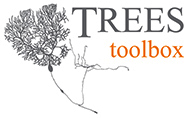
adapted from
PLoS supp. material
by Hermann Cuntz

![]()
The ged_ panel is useful to rearrange the morphologies of different trees
in relation to other sets of trees.
Either interactively or indirectly using the buttons on the ged_ panel,
trees can be scaled, rotated, flipped or moved and their cable diameter
can be globally increased or reduced.
All these functions are applicable to all trees in a group directly
if the „G“ toggle is switched on.
Apart from the edit modes, two further features of the ged_ panel
are explained in more detail in the following page.

Simple black 2D-patches or full rainbow colour 3D cylinder models
of all cells in a group can be displayed using the first or second radio
button respectively. For huge groups of trees this can become slow.

With the „spread“ button, trees of one group are spread out in 2D
for a better overview
(see “spread_tree”).
The process is reversible as long as the tree order in the group is unchanged.
To set all root coordinates to zero, first toggle „G“ and then press „0“ button.

By pressing the „concat“ button, a tree in a group is connected
to the immediately preceding tree it
(see “cat_tree”).
The tree is connected at its root to the node of its connection partner which is closest.
Arrange the trees ahead of time using the different buttons of the ged_ panel
or the edit mode.
A sub-tree can be for example cut out using the mtr_ panel function „discon“.

A number of visualization and exports exist for tree groups summarized graphically below.

ged_ edit mode
With the ged_ panel, different trees can be arranged in relation
to each other by scaling, rotating and moving them individually or together.
In the edit mode this is done interactively using the mouse movements.
Take for example a tree of an HSN (black) and an HSE (red) tangential cell
of the fly and switch to the edit mode.
By toggling between the three submodes “scale”,
“rotate” and “move” the trees can be arranged to place them together
as if they were reconstrucitons from the same Lobula plate.
The red dashed edit line indicates which tree is closest to the cursor.
By double click of the mouse that tree can be activated.
Switching between trees of the active group is also possible with ctrl [a] and [d] keys.
The implementation of an interactive rotation is not great yet.


This work is licensed under a
Creative Commons Attribution-Noncommercial-Share Alike 3.0 License